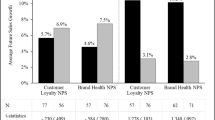Abstract
Although there is much controversy in the economic literature about how advertising affects market competition, little is known about the effect of advertising on product innovation. We examined the relationship between advertising expenditures and the research and development activities of pharmaceutical firms using empirical data from eight therapy areas. This study finds that detailing advertising may have a significant positive effect on the number of new products entering into clinical development. Markets of chronic disease with high levels of detailing advertising were more attractive to pharmaceutical firms. However, the effect of advertising on new product novelty remains inconclusive.
Similar content being viewed by others
References
Acemoglu, D., & Linn, J. (2003). Market size in innovation: Theory and evidence from the pharmaceutical industry. Working paper no. 10038, National Bureau of Economic Research, Cambridge, MA.
Calfee J.E. (2002). The role of marketing in pharmaceutical research and development. Pharmacoeconomics 20(Suppl 3): 77–85
DiMasi J.A. (2001a). New drug development in the United States from 1963 to 1999. Clinical Pharmacology and Therapeutics 69: 286–296
DiMasi J.A. (2001b). Risks in new drug development: Approval success rates for investigational drugs. Clinical Pharmacology and Therapeutics 69: 297–307
DiMasi J.A., Hansen R.W., Grabowski H.G. (2003). The price of innovation: New estimates of drug development costs. Journal of Health Economics 22: 151–185
Drug Facts and Comparisons, 2001 ed. St. Louis, Missouri: Facts and Comparisons, A Wolters Kluwer company.
Drugs Under Patent. (2002). Gaithersburg, MD: Freedom of Information Services, Inc.
Ellison, G., & Ellison, S. F. (2000). Strategic entry deterrence and the behavior of pharmaceutical incumbents prior to patent expiration. Retrieved April 4, 2007, from Massachusetts Institute of Technology, Department of Economics. website: http://www.mit.edu/faculty/download_pdf.php?id=225
Findlay S.D. (2001). Direct-to-consumer promotion of prescription drugs. Economic Implications for patients, payers and providers. Pharmacoeconomics 19(2): 109–119
Finkelstein, A. (2003). Health policy and technological change: Evidence from the vaccine industry. Working paper no. 9460, National Bureau of Economic Research, Cambridge, MA.
Frank R.G. (2003). New estimates of drug development cost. Journal of Health Economics 22: 325–330
Grabowski H., Vernon J. (1986). Longer patents for lower imitation barriers: The 1984 Drug Act. American Economic Review 76(2): 195–198
Hurwitz M.A., Caves R.E. (1988). Persuasion or information? Promotion and the shares of brand name and generic pharmaceuticals. Journal of Law & Economics 31(2): 299–320
Kaiser U. (2005). A Microeconometric note on product innovation and product innovation advertising. Economics of Innovation and New Technology 14(7): 573–582
Leffler K.B. (1981). Persuasion or information? The economics of prescription drug advertising. Journal of Law and Economics 24(1): 45–74
Narayanan S., Desiraju R., Chintagunta P.K. (2004). Return on investment implications for pharmaceutical promotional expenditures: The role of marketing-mix interactions. Journal of Marketing 68(October): 90–105
Scherer F.M. (2001). The link between gross profitability and pharmaceutical R&D spending. Health Affairs 20(5): 216–220
Scott Morton F.M. (2000). Barriers to entry, brand advertising, and generic entry in the U.S. pharmaceutical industry. International Journal of Industrial Organization 18(7): 1085–1104
Steinke D.T., MacDonald T.M., Davey P.G. (1999). Doctor-patient relationship and prescribing patterns. View from primary care. Pharmacoeconomics 16(6): 599–603
Telser L.G., Best W., Egan J.W., Higinbotham H.N. (1975). The theory of supply with application to the ethical pharmaceutical industry. Journal of Law and Economics 18(2): 449–478
United States Pharmacopeia Dispensing Information Volume I—Drug Information for the Health Care Professional, 20th ed. Englewood, CO: Micromedex, Inc.
Wiggins S.N. (1981). Product quality regulation and new drug introductions: Some new evidence from the 1970s. Review of Economics and Statistics 63(4): 615–619
Wooldridge J.M. (2002). Econometric analysis of cross section and panel data. Cambridge, MIT Press
Wosinska, M. (2002). Just what the patient ordered? Direct-to-consumer advertising and the demand for pharmaceutical products. HBS Marketing Research Paper Series, No. 02–04, 2002. doi: 10.2139/ssrn.347005
Author information
Authors and Affiliations
Corresponding author
Rights and permissions
About this article
Cite this article
Kwong, W.J., Norton, E.C. The Effect of Advertising on Pharmaceutical Innovation. Rev Ind Organ 31, 221–236 (2007). https://doi.org/10.1007/s11151-007-9146-8
Published:
Issue Date:
DOI: https://doi.org/10.1007/s11151-007-9146-8




